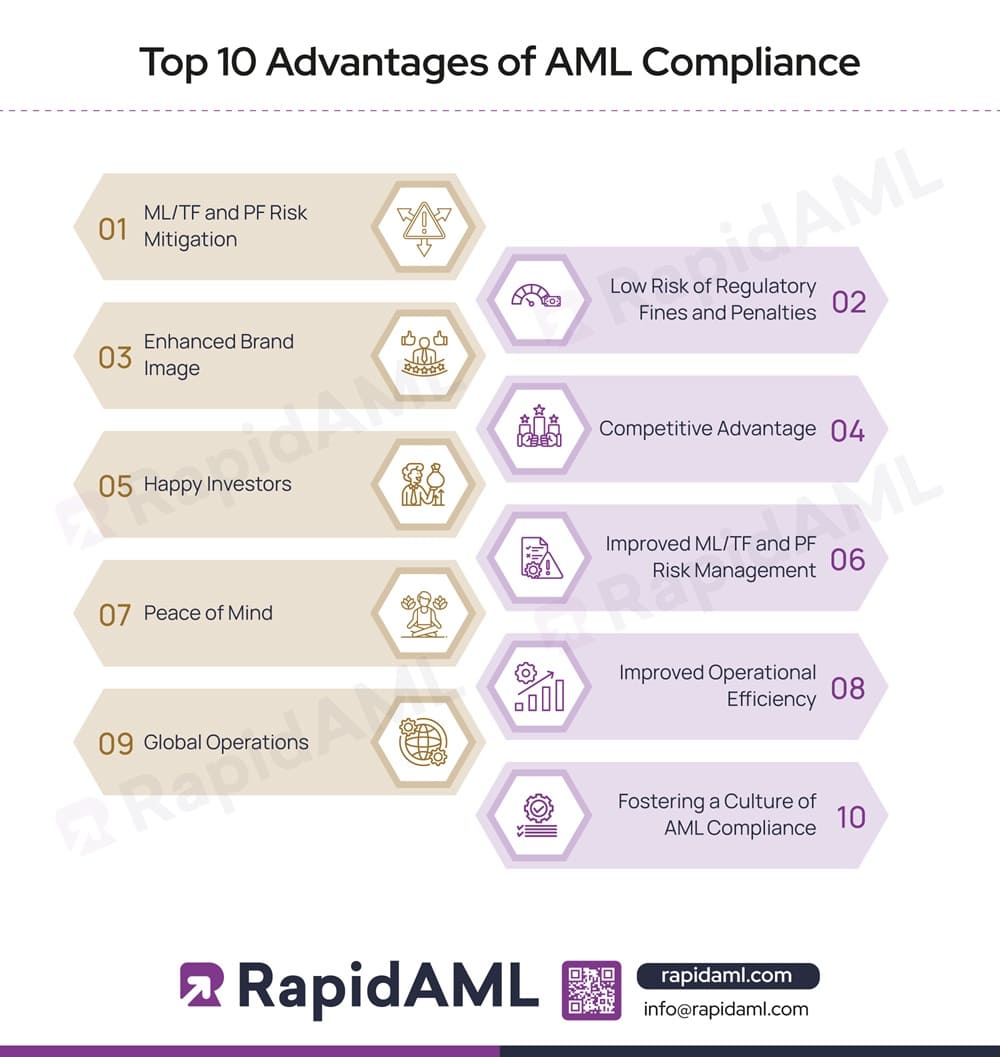
RapidAML Team
2024-06-18
Many entities may consider anti-money laundering (AML) compliance to be unnecessary overhead for their business. The AML compliance department is often perceived as a cost center. In this blog, we will highlight the advantages of AML compliance, which show how adherence to AML regulatory requirements results in long-term business success and stability. Here are the top 10 advantages of AML compliance.

Money Laundering (ML), Terrorism Financing (TF), and Proliferation Financing (PF) are financial crimes that negatively impact a country’s financial ecosystem and may lead to heightened criminal activities. When a business is used as a conduit for these financial crimes unwittingly, it loses its reputation, the trust of its customers, and its operational efficiency. It is also exposed to fines and penalties under AML regulations, which may even lead to the closing down of its business. Therefore, ML/TF and PF risk mitigation is paramount.
AML compliance involves adopting measures such as Customer Due Diligence (CDD), conducting Name Screening, Customer Risk Assessment, etc. These AML compliance obligations help entities regulated under AML laws detect and deal with financial crime risks in a prompt manner. Therefore, complying with AML requirements helps entities mitigate and manage ML/TF and PF risks.
For more information, read our extensive guide on Mitigating Money Laundering Risks.
One of the most important benefits of adhering to AML compliance obligations is the substantial reduction in the risk of facing regulatory fines and penalties due to any violations of the same.
Non-compliance with AML obligations may result in hefty fines, which can thwart the normal business operations of the entity. However, the consequences of AML non-compliance go beyond just financial penalties. It can lead to lawsuits, prolonged investigations, increased scrutiny by AML regulators and even criminal charges against the board members, executive managers, and owners of the entity.
On the other hand, building a strong Anti-Financial Crime Compliance Program results in a positive reputation, improving relations with the AML regulators while reducing the risk of heavy punishments.
AML compliance improves the reputation of the entity, which in turn enhances its brand image. Any perception of involvement in financial crimes can erode customer confidence. Customers and other stakeholders trust businesses that adhere to AML regulatory requirements and adopt ethical practices. A positive brand image attracts more clients, contributing to long-term business growth and success. Therefore, while AML compliance may feel like a cost at first, it results in cost savings, profits, and benefits in the long run.
AML compliance is a strategic and competitive advantage for businesses. The advantages that businesses can attain through AML compliance include:
Investors are usually cautious regarding their investment decisions. They do not want to place their funds in entities that may be involved in financial crimes and are conduits to the movement of illicit funds. Investors prefer entities which demonstrate good ML/TF and PF risk management practices, reliability in terms of adherence to AML compliance, and stability. Therefore, a history of AML compliance and excellence helps entities attract and retain investors as well as boost their confidence.
Flip the Script on Financial Crime Risks
Let RapidAML be your sidekick in your AML compliance journey
AML compliance helps entities adopt sound ML/TF and PF risk management practices. The first step towards implementing an AML program is Enterprise-Wide Risk Assessment (EWRA), which is the process of evaluating the financial crime risks a business is exposed to. This allows the business to adopt AML compliance systems and controls that are suited to its needs and tailored to address its unique ML/TF and PF risk exposure. It also helps entities adopt a risk-based approach, that is, concentrating its limited resources to tackle the highest risks of ML/TF and PF. This ensures efficient allocation of resources, saving costs while improving protection against financial crimes.
Ensuring AML compliance reduces the risk of an entity being used as a conduit for financial crimes or being non-compliant with AML regulations. Therefore, AML compliance becomes a source of peace of mind for the business, allowing it to focus on its growth without stressing about the consequences of not complying with AML obligations.
While many may view AML compliance as a costly and time-consuming process, businesses that streamline their AML Programs see improvements in overall operational efficiency. This is so because proper AML systems allow entities to understand the financial crime risks they can and cannot handle, allowing them to align their business decisions with their ML/TF and PF risk appetite. This results in operational efficiency due to reduced ML/TF and PF risks.
Further, when entities choose to adopt AML automation to improve their AML compliance, manual errors are minimised while the time taken to complete AML tasks is reduced. This translates to better operational efficiency. For example, customer onboarding can be rapidly conducted, suspicious transactions indicating financial crime risks can be quickly investigated, senior management’s permission for tasks such as onboarding of Politically Exposed Persons (PEP) can be promptly sought, etc.
Entities with strong AML compliance programs are better positioned to expand globally. Businesses that have a culture of AML compliance take into consideration international AML standards and best practices while implementing their AML Policies, Procedures, and Controls. This prepares them with the resources to rapidly understand and implement AML regulatory requirements in the countries they expand to.
When businesses strictly adhere to AML compliance and demonstrate intolerance towards financial crimes, it helps inculcate a culture of AML compliance within the organisational structure of the business. This results in a multiplier effect, ensuring that all stakeholders involved in the entity’s AML compliance understand their roles and responsibilities and uphold the ethical values of integrity, accountability, and transparency.
The advantages of AML compliance discussed in this blog demonstrate that it is a strategic advantage rather than a sunken cost. It leads to long-term growth and benefits, improves business functions, and ensures stability in operations through protection from financial crime risks.
Confused about where to start with AML compliance?
RapidAML helps you solve the compliance puzzle, piece by piece
Dipali is an Associate member of ICSI and has a Bachelor’s in Commerce and a General Law degree.
She currently assists clients by advising and helping them navigate the legal and regulatory challenges of Anti-Money Laundering Law. She also helps companies develop, implement, and maintain effective AML/CFT and sanctions programs.
She knows Anti-money laundering rules and regulations prevailing in GCC countries and specializes in Enterprise-wide risk assessment, Customer Due-diligence, and Risk assessment.
Solutions
Transaction Monitoring
Regulatory Reporting
Services
Industries
Lorem Ipsum
Lorem Ipsum
Lorem Ipsum
Lorem Ipsum
Lorem Ipsum
© RapidAML 2025
Solutions
Transaction Monitoring
Regulatory Reporting
Services
AML/CFT Health Check
Industries
Lorem Ipsum
Lorem Ipsum
Lorem Ipsum
Lorem Ipsum
Lorem Ipsum
© RapidAML 2025
Sign Up Form